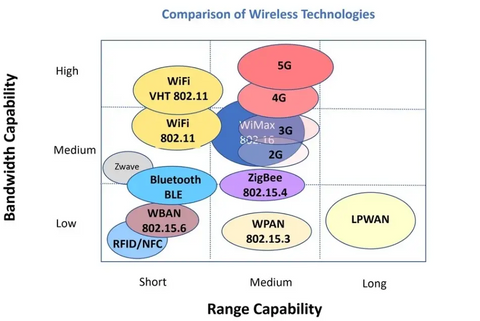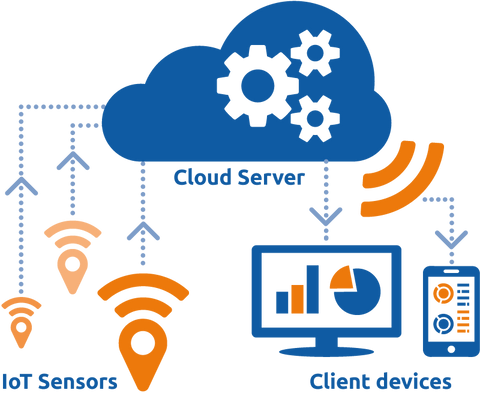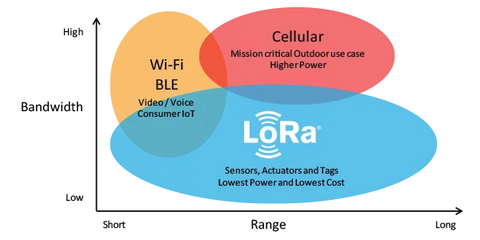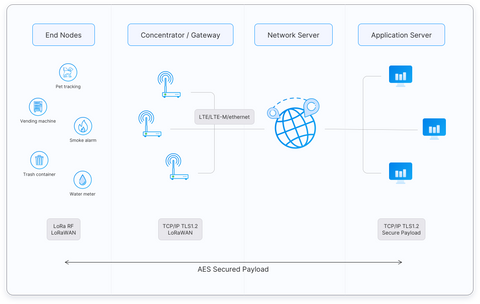Introduction
In this article we're going to demystify the confusing world of wireless communication technologies and the Internet of Things. We're going to focus on a recent addition to the wireless landscape called LoRaWAN which is turning out to be a great candidate for remote monitoring applications. LoRaWAN technology helps engineers design lower-cost and easy-to-use products for remote monitoring applications.
What are wireless communications technologies?
To set the scene, it's worth spending a few moments reviewing the fundamentals of wireless communication technologies. But don't worry, there is no mathematics involved. Put simply, wireless communication is a way of transferring information between locations A and B without using any electrical conductor or physical medium. All wireless communication systems have three key elements, the transmitter, the receiver and the channel.
The transmitter
The transmitter first encodes the digital information to be transmitted in order to minimize signal corruption during transmission caused by noise in the transmitter and receiver electronics and atmospheric disturbances. Secondly, the data is encrypted for security. The encoded and encrypted data is then turned into an electrical signal in the modulator. Finally, the electrical signal is radiated towards the receiver, using the antenna. Naturally, practical transmitters have a few more intermediate steps, but these are the main ones.
The channel
After departing the antenna, the signal travels through the free-space medium we call the channel. In a wired system, the channel is a cable.
The receiver
The receiver simply reverses the transmitter's operations.

Remember that in a practical system, all these blocks are hidden from the end user. But with this brief overview, hopefully you get a feel for all the work happening under the hood.
Advantages of wireless technologies
Wireless communications technologies are all about making life easier. Here are some of the key advantages:
- Wireless network systems are easy to set up, cheaper to install, and also maintain.
- Information (data, videos, etc.) is transferred quickly and faster.
- Low maintenance and installation costs compared to wired networks.
- Advanced coverage. You can access the wireless technologies anywhere at any time.
- They are no more carrying wires and cables to get the connection.
- Enables professionals to work anywhere remotely.
- Emergencies can now be sorted out quickly with wireless communication. Immediate support is rendered via cellular networks.
- You can carry and re-install it anywhere, anytime.
- Wireless technologies are more adaptable to new environments than wired networks.
Disadvantages of wireless technologies
But as with every technology there are disadvantages as well.
- Security can be an issue since the signal is transmitted into free space.
- Wireless technologies can be affected interference from other signals.
- Wireless signals be jammed, negatively affecting signal quality.
- Data rates can be variable depending on your location relative to the transmitter.
- Wireless signals have a limited range.
In most practical system, these limitations are overcome through encryption, better modulation methods, and higher transmitter power.
Examples of wireless technologies
The variety of wireless communication systems has exploded since the Italian inventor Guglielmo Marconi first transmitted a radio signal over 125 years ago. Here are some of the main systems:
- Radio and television broadcasting
- Mobile telephone systems (3G, 4G, 5G, 6G)
- Cordless phones systems
- Global positioning system (GPS)
- Radar
- Infrared communication
- Satellite communication
- Wi-Fi
- Microwave communication
- Radio Frequency Identification (RFID)
- Zigbee
- Bluetooth
Each system has been designed with a different set of applications in mind. Engineers must trade off connection speed (bandwidth) against range. There is no concept of one-size-fits-all in the wireless market. Once must select the technology to match the requirements. Luckily, for remote monitoring applications there is an excellent choice, as we will show later in this article.

What is the Internet of Things?
Now that we've covered the basics of wireless communications, let's talk about the next revolution sweeping the landscape. You've probably heard of the Internet of Things or IoT. In simple terms, the IoT refers to the digitally connected universe of smart devices. These devices are embedded with internet connectivity, sensors and other hardware that allow communication and control via the web.
IoT can be found in an array of devices, industries and settings. From smart blackboards in school classrooms to medical devices that can detect signs of Parkinson’s disease. IoT is rapidly making the world smarter by connecting the physical and the digital.
The number of IoT-connected devices grew by 8 percent in 2021 and is projected to leap by another 22 percent through 2025, reaching 27 billion devices. Examples of the IoT span many industries, from manufacturing and automotive to healthcare and retail.
Examples of IoT
The connected smart home is a prime example of the Internet of Things in action. Internet-enabled thermostats, doorbells, smoke detectors and security alarms create a connected hub where data is shared between physical devices and users can remotely control the “things” in that hub via a mobile app or website.
The Internet of Things isn’t just restricted to everyday items in the home. Its influence can be seen across industries, making its way into the automotive industry, for example, by facilitating connectivity for monitoring and optimizing vehicle performance. The healthcare industry also benefits from the IoT, giving providers tools to more efficiently and accurately track key health metrics like glucose levels.
In a nutshell, IoT works like this:
- Devices (like water tanks) have hardware, like sensors (water level sensors), that collect data (like water levels).
- The data collected by the sensors is then shared via the cloud using one or more wireless communication systems outlined above and integrated with software.
- The software then analyzes and transmits the data to users via an app or website.

IoT Applications
New IoT applications are being developed every day. But here some of the more mature applications.
- Thermostats and security systems for smart homes
- Wearables for health and fitness tracking
- Diagnostics for autonomous vehicles
- Automation for smart factories
- Lighting and traffic systems for smart cities
- Crop monitoring
- Tank level monitoring
- Retail supply chain tracking
- Monitoring and diagnosing disease
Common wireless technologies for IoT
IoT benefits are largely made possible by technologies that connect devices and enable them to communicate with one another. Connectivity options have a range of pros and cons, with some more suitable for certain use cases like smart homes while others may be more appropriate for IoT applications like industrial automation.
- Wi-Fi
- Bluetooth
- Zigbee
- Cellular
- Sigfox
- LoRaWAN
Which technology is best for IoT?
It's always tricky to make a blanket statement about any technology, and wireless technologies are no different. That said, LoRaWAN based on LoRa technology is making huge inroads into the IoT industry.
What is LoRa?
LoRa stands for Long Range. It’s based on a type of wireless modulation (see our earlier discussion) called spread spectrum modulation which gives it very long-range capability and resilience to interference and jamming. LoRa’s physical range is approximately 10+ kilometers in ideal conditions.

What is LoRaWAN?
LoRaWAN stands for Long Range Wide Area Network. It is a network built using of devices that use LoRa modulation to communicate. It is a software layer which defines how devices use the LoRa hardware, for example when they transmit, and the format of messages.

Here's is a list that defines what all the components in the LoRaWAN are:
- End Devices- sensors or actuators send LoRa modulated wireless messages to the gateways or receive messages wirelessly back from the gateways.
- Gateways- receive messages from end devices and forward them to the Network Server.
- Network Server- a piece of software running on a server that manages the entire network.
- Application servers- a piece of software running on a server that is responsible for securely processing application data.
- Join Server- a piece of software running on a server that processes join-request messages sent by end devices (The Join Server is not shown in the above figure).
Key advantages of LoRa and LoRaWAN
LoRa technology is a revolutionary platform that provides low power consumption and robust security. It has become the de facto wireless platform for the IoT. It allows users to transmit data over long ranges at an affordable price point. LoRa offers efficient solutions for problems in rural or indoor situations where cellular or Bluetooth networks are ineffective. And importantly,LoRa technology gets IoT projects off the ground faster than its alternatives. Here is a summary of what makes LoRa and LoRaWAN so awesome.
- Ultra-low power- LoRaWAN end devices are optimized to operate in low power mode and can last up to 10 years on a single coin cell battery.
- Long range- LoRaWAN gateways can transmit and receive signals over a distance of over 10 kilometers in rural areas and up to 3 kilometers in dense urban areas.
- Deep indoor penetration- LoRaWAN networks can provide deep indoor coverage, and easily cover multi floor buildings.
- License free spectrum- You don’t have to pay expensive frequency spectrum license fees to deploy a LoRaWAN network.
- Geolocation- A LoRaWAN network can determine the location of end devices using triangulation without the need for GPS. A LoRa end device can be located if at least three gateways pick up its signal.
- High capacity- LoRaWAN Network Servers handle millions of messages from thousands of gateways.
- Public and private deployments- It is easy to deploy public and private LoRaWAN networks using the same hardware (gateways, end devices, antennas) and software (UDP packet forwarders, Basic Station software, LoRaWAN stacks for end devices).
- End-to-end security- LoRaWAN ensures secure communication between the end device and the application server using AES-128 encryption.
- Firmware updates over the air - You can remotely update firmware (applications and the LoRaWAN stack) for a single end device or group of end devices.
- Roaming- LoRaWAN end devices can perform seamless handovers from one network to another.
- Low cost - Minimal infrastructure, low-cost end nodes and open source software.
- Certification program- The LoRa Alliance certification program certifies end devices and provides end-users with confidence that the devices are reliable and compliant with the LoRaWAN specification.
- Ecosystem- LoRaWAN has a very large ecosystem of device makers, gateway makers, antenna makers, network service providers, and application developers.
LoRaWAN applications
Here are a few LoRaWAN use cases:
- Vaccine cold chain monitoring - LoRaWAN sensors are used to ensure vaccines are kept at appropriate temperatures in transit.
- Animal conservation - Tracking sensors manage endangered species such as Black Rhinos and Amur Leopards.
- Dementia patients - Wristband sensors provide fall detection and medication tracking.
- Smart farms- Insights into crop soil moisture and optimized irrigation schedule reduce water use up to 30%.
- Tank level monitoring- Track liquid levels so tanks are never empty when they're not supposed to, detect leaks, track liquid usage.
- Water conservation- Identification and faster repair of leaks in a city’s water network.
- Food safety- Temperature monitoring ensures food quality maintenance.
- Smart waste bins - Waste bin level alerts sent to staff optimize the pickup schedule.
- Smart bikes- Bike trackers track bikes in remote areas and dense buildings.
- Airport tracking - GPS-free tracking monitors vehicles, personnel, and luggage.
- Efficient workspaces - Room occupancy, temperature, energy usage and parking availability monitoring.
- Cattle health - Sensors monitor cattle health, detect diseases and forecast delivery time.
